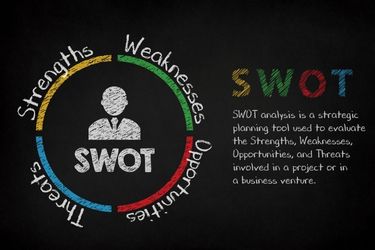
SWOT stands for strengths, weaknesses, opportunities, and threats. A SWOT analysis gives an organization a clear summary of its current operational state to use for future business planning. It's often presented in four boxes, with a box for each SWOT element. Here are essential points on how to create a SWOT analysis.

The secret to how to get repeat business isn't hidden from entrepreneurs. It involves understanding your market and what your available resources can do to gain market share. Understanding how to create a SWOT analysis leads to forming a roadmap from the past and present to the future, similar to a business plan, but more of a concise visual snapshot.
Conducting a SWOT analysis requires doing research on your own operation, your direct competitors, the industry, and your market. You can then make objective accurate lists of your organization's strengths, weaknesses, opportunities, and threats. Keep in mind that strengths and weaknesses are internal factors while opportunities and threats are external factors. Here are widely-used practices for conducting accurate SWOT analyses:
The best way to start your SWOT analysis is by observing other examples in your industry. The best design for this tool is a grid-like matrix like a window surrounding a "plus" sign. You simply insert the lists in the appropriate boxes, giving the viewer a four-way framework that allows them to see all four lists at once. This type of presentation makes the information easy to read, understand and remember, much like an infographic.
To make your visual presentation even more informative, create a PEST analysis to place
alongside your SWOT analysis. PEST stands for political, economical, social, and technological concerns. These four external forces can potentially impact your operation beyond your control. It adds more depth to your risk factors, as being aware of risks is the first step toward forming reliable risk management strategies.
Once you have a layout for your SWOT analysis, you can then fill in the boxes with lists for each SWOT category. The lists in each box can be any length, but ideally should be narrowed to the most important items through careful evaluation. Here are examples of the criteria you should consider:

Employing experienced talent, high productivity, and cost-efficiency can all be considered significant business strengths. Sometimes management isn't even aware of strengths within its staff until conducting a thorough SWOT analysis. Engagement with employees can give managers deeper insights into what the team is capable of achieving.
Clearly, business success is largely built on strong communication. Without effective communication, an organization becomes disjointed as the building blocks of teamwork fall apart. A strong team is a reflection of both strong leadership, smart hiring, and effective training.
Limited resources, labor shortages, and supply chain issues are among the most commonly cited weaknesses on SWOT charts. Broader economic uncertainty can be another weakness or threat to a business that exists on limited funding. Without a sufficient capital base, unexpected disasters can cause a small business to collapse overnight. A business is particularly vulnerable if it lacks insurance to protect its assets.
Sometimes the biggest weaknesses of a company are its internal or external communication. Outsourcing to a low-cost offshore customer service call center, for example, can lead to language barriers in which customers can't understand the representatives. Any type of weakness these days perceived in the customer experience can lead to consumers quickly searching for alternatives online.

Consumers are buying more online and seeking personalized services, which are trends that open up blossoming opportunities. Since smartphone shoppers are the most ready-to-buy customers, a local establishment that utilizes e-commerce has competitive advantages. Another opportunity that exists for small businesses includes the ability to hire remote workers as a cost-saving measure. Opportunities also exist in technology for a firm to get more work done in less time using automation.
Listing opportunities don't necessarily only have to include concrete ideas, as long as they are within the realm of possibility. External opportunities are similar to internal strengths in the sense they point to potential revenue or other forms of business growth.
Cybersecurity issues are a growing concern across all industries. Healthcare organizations must follow HIPAA regulations to ensure the privacy of patient medical records. A breach of personal data can trigger class-action lawsuits, which can drive an organization into bankruptcy. Other threats beyond cybercrime exist for all businesses, depending on location, type of product or service, personnel, and affiliations.
Threats may exist in the form of physical as well as economic problems. Climate change poses threats of natural disasters that can disrupt an enterprise, especially in areas prone to flooding or wildfires. A company can draw from its strengths to formulate ideas on overcoming threats and vulnerabilities of various types.

In order for your SWOT analysis to be meaningful in terms of improving your organization, it must be honest and refined. In other words, it shouldn't be used for wishful thinking, as it's best used for strategic planning. Focusing on financial strengths and weaknesses is an important part of this analysis, but you should also consider the strengths and weaknesses of customers, employees, and market conditions.
The external factor of potential opportunities helps managers and sales teams rethink their priorities in how they spend their time and resources. Opportunities can come from targeting new market segments, creating new business partnerships, and outsourcing to third parties. Listing external threats helps identify the organization's risk management strategies.
One of the best reasons to conduct strategic analysis is to determine if your organization is in a position to grow or if there's a dead-end ahead. It can help you cut losses early if your analysis reveals that the operation will use up investment capital before it's able to generate a profit. Another reason for this analysis is that the pros and cons can help you determine realistic milestones.

Ideally, your SWOT analysis will provide a long-term roadmap for your operation with the understanding that there should be adjustments along the way. By bringing your main strengths, weaknesses, opportunities, and threats together in one visual, you'll have relevant facts to trigger enhancement ideas when brainstorming with your team.
The overall analysis will help you build upon your internal strengths and external opportunities. You'll get a clear picture of prioritizing the weaknesses you can control within your organization. It will also raise awareness about external threats to your company's business survival.
This gathered information presented in one place will help you plan business strategies for improving productivity while cutting waste. By including SWOT elements in your strategic planning, you'll reduce the costs of maintenance and cut waste as much as possible. Furthermore, it will prepare your organization better for disasters.
A business of any size can use SWOT analyses to investigate internal and external factors that affect the organization's ability to maintain business continuity and generate revenue. The results can ultimately boost the customer experience and other areas of the business that are crucial for sales. Ultimately, it will guide your business toward greater operational efficiency and a competitive edge.
Goals to improve operations and increase sales can be met through careful strategic planning driven by well-researched data. It is essential to consider SWOT elements in your business priorities to assure the necessary actions needed for success are implemented. Once your plan is in place you can focus on maximizing your team's training and efficient management of time to further improve your bottom line.
A SWOT analysis is a four-box assessment that lists your organization's strengths, weaknesses, opportunities and threats. It condenses research about your operation, competitors and market into one visual, allowing leaders to spot advantages, vulnerabilities and strategic priorities quickly.
Strengths and weaknesses originate inside the company—things you control such as talent, culture, finances or processes. Opportunities and threats come from outside forces like market trends, technology shifts, regulations or competitors' moves. Classifying items this way clarifies what you can change versus what you must adapt to.
1) Gather data on your business, industry and direct rivals. 2) Invite employees from varied levels to brainstorm raw lists. 3) Encourage honest, specific wording. 4) Vote or score items to narrow each list to priorities. 5) Place the final points in a four-quadrant template and discuss resulting strategies.
A PEST analysis reviews Political, Economic, Social and Technological forces that might influence your company. Laying it beside your SWOT adds context to the external half—opportunities and threats—helping you validate which trends are favorable, which are risky and what contingency plans or innovations you should pursue.
Update the matrix at least annually or whenever major changes occur—new competitors, regulatory shifts, funding rounds, product launches, economic shocks. Regular reviews ensure the document reflects current realities, keeps strategies relevant and lets you track progress on previously identified strengths, weaknesses, opportunities and threats.